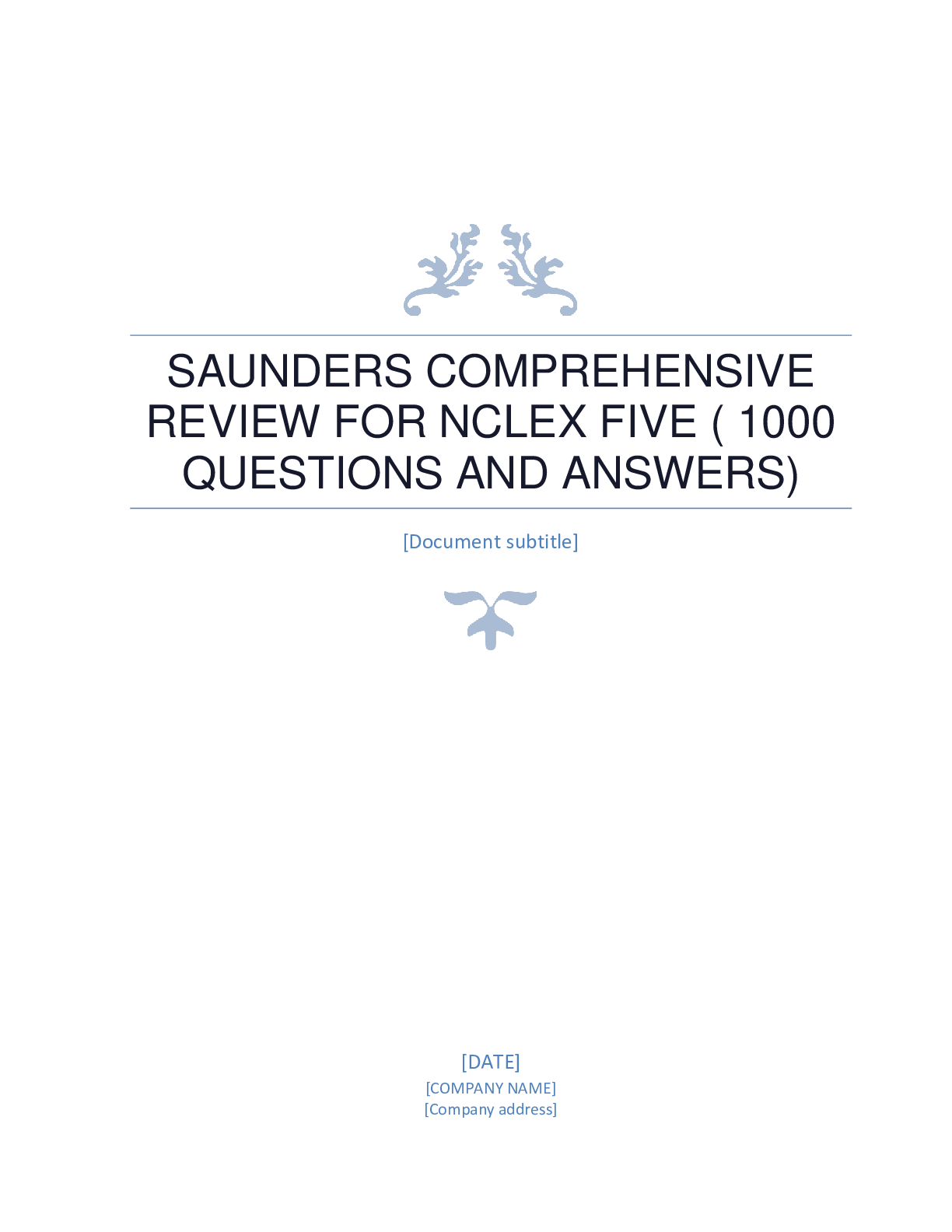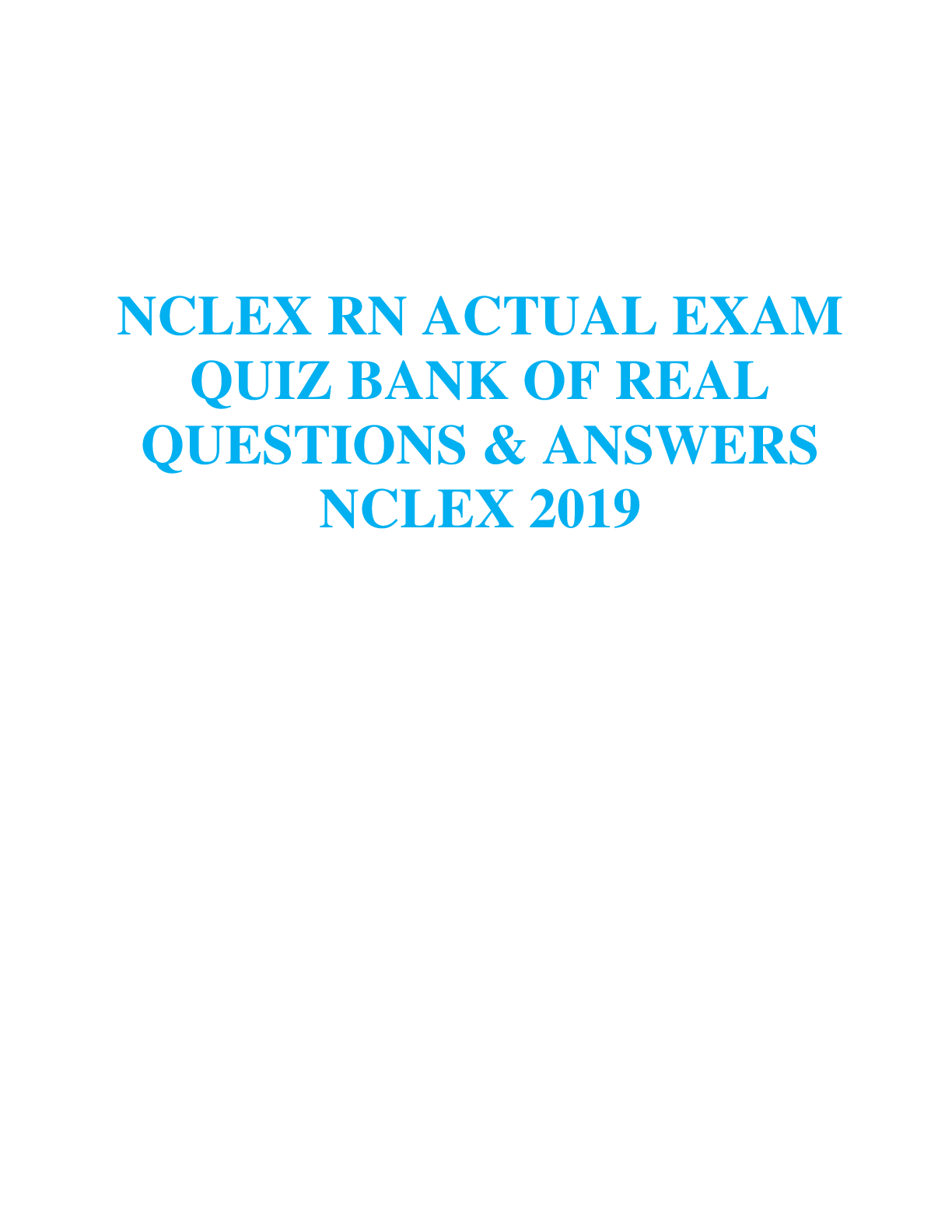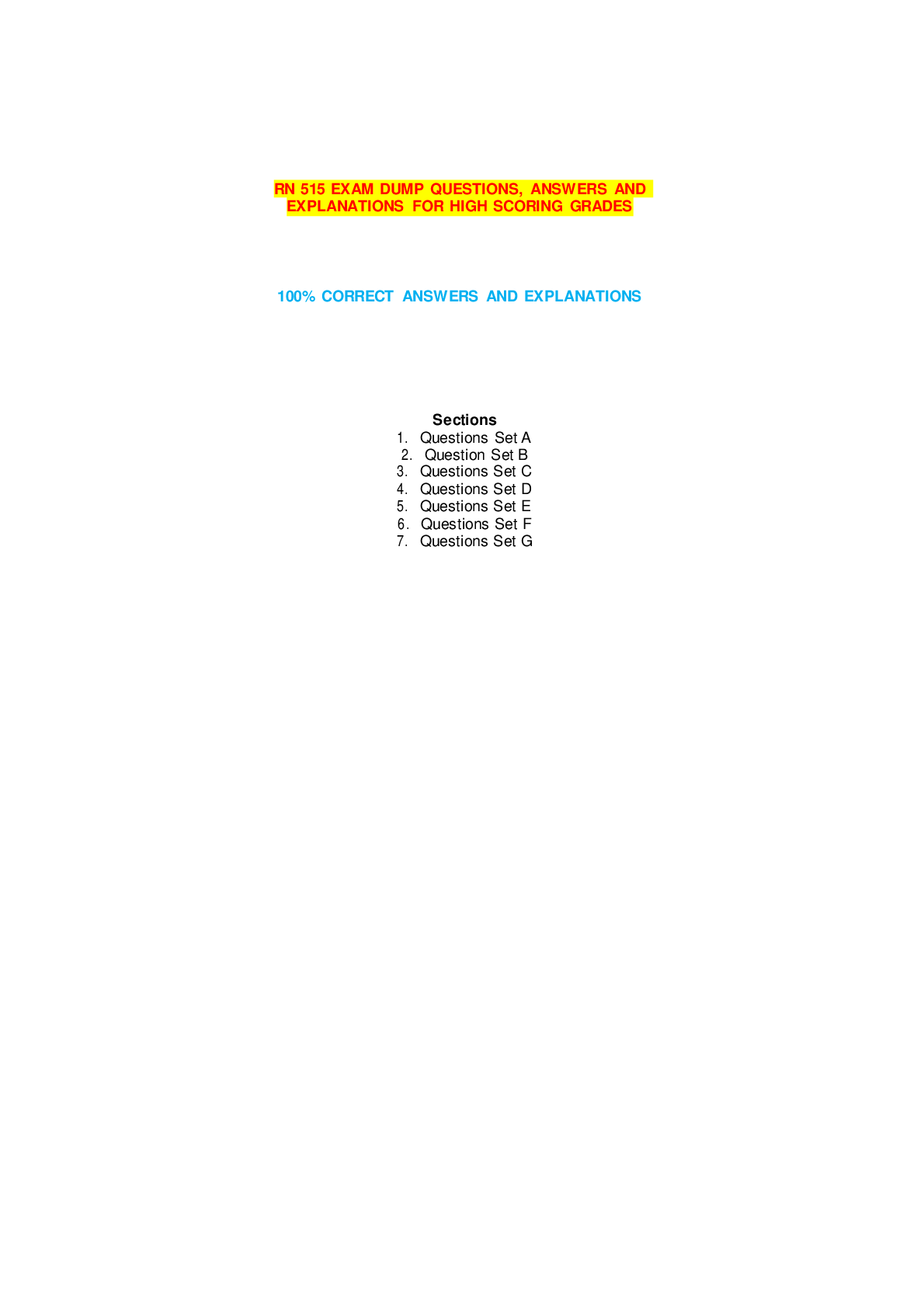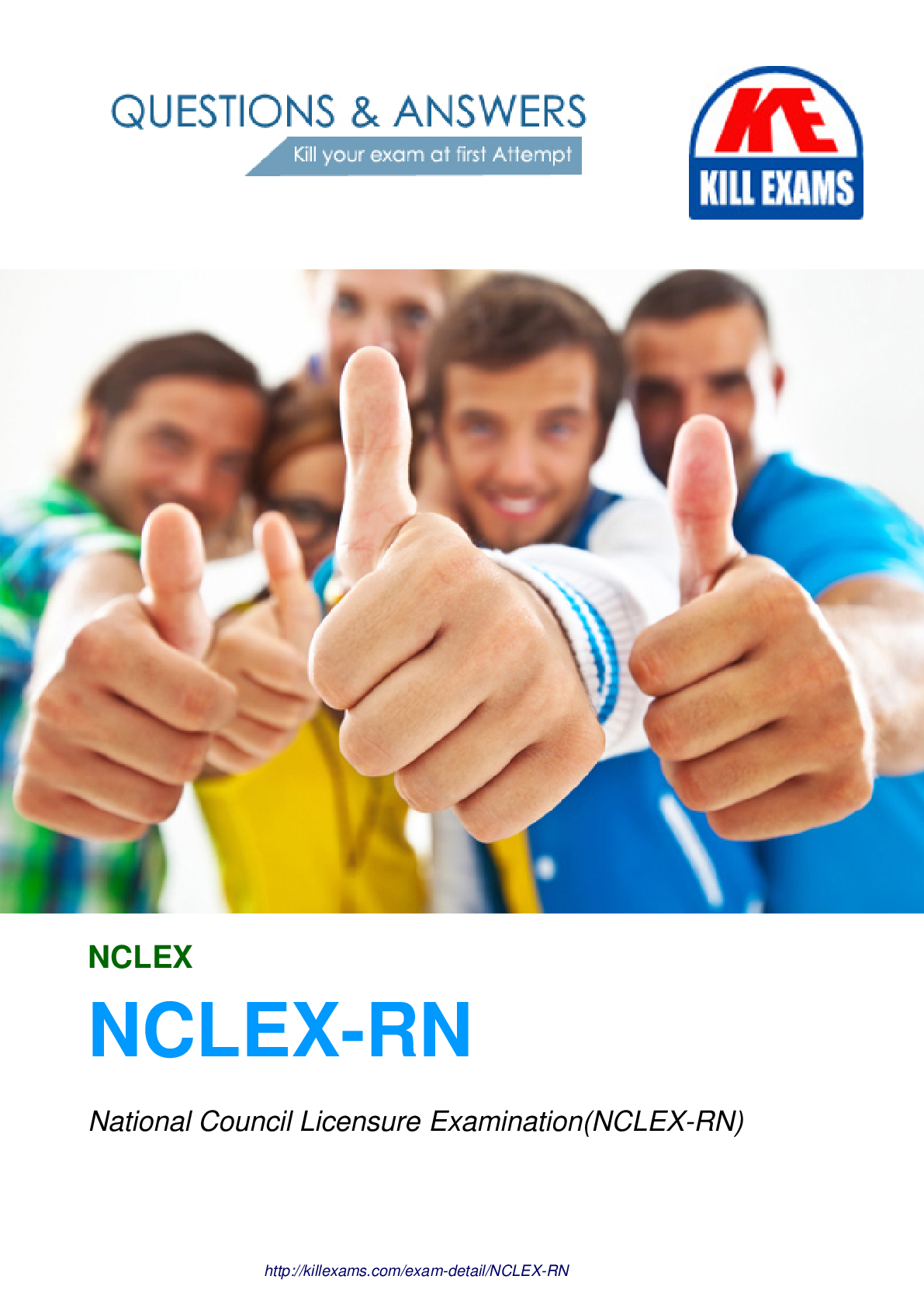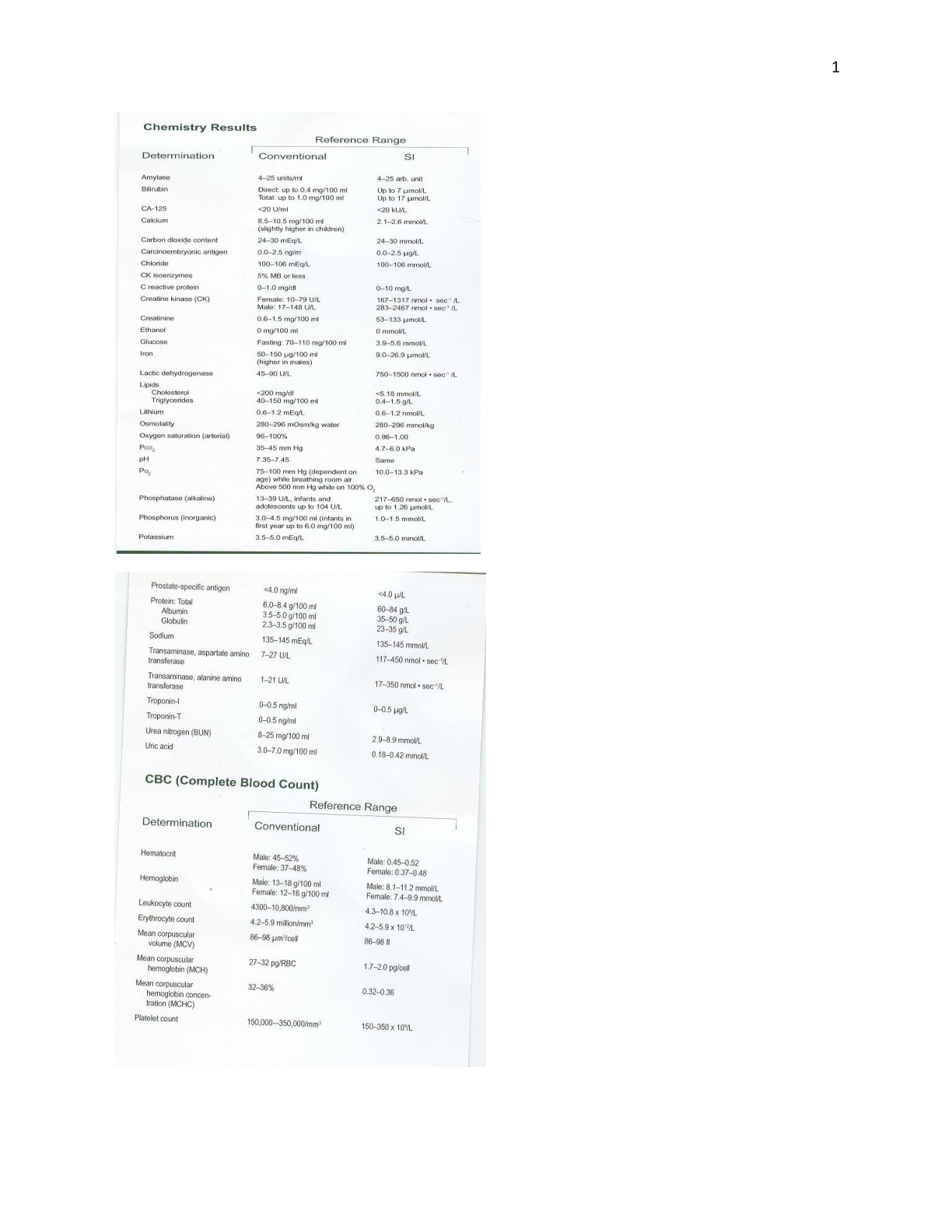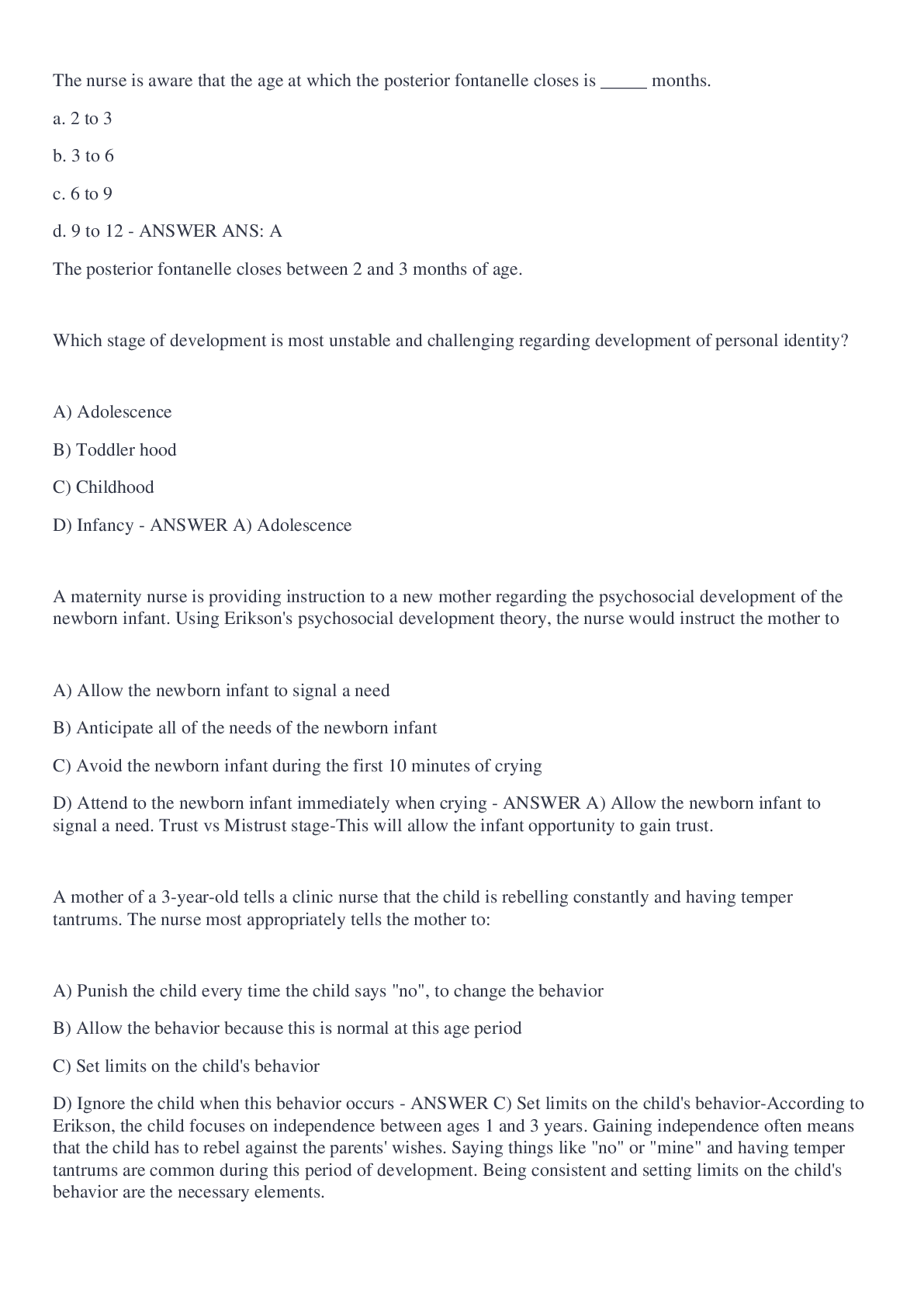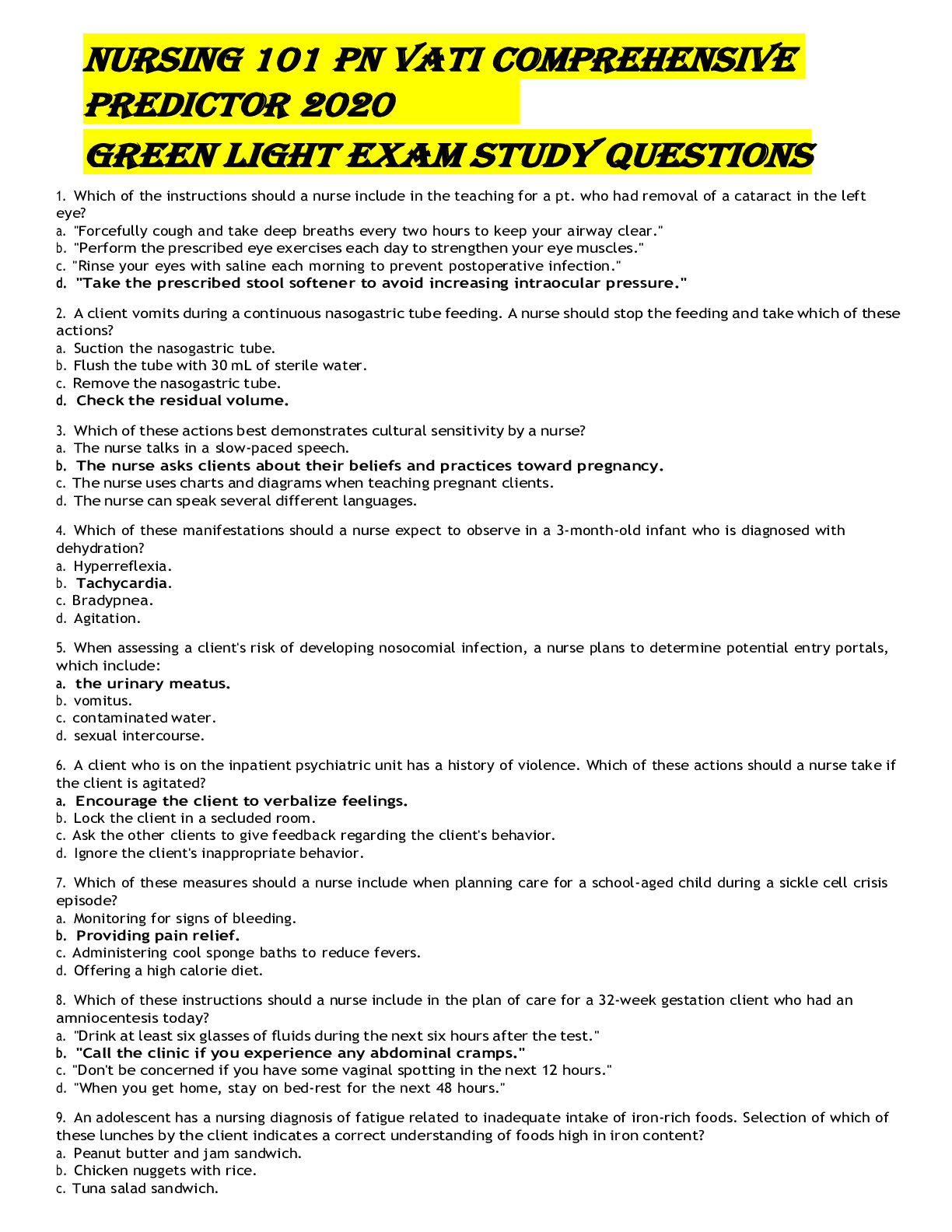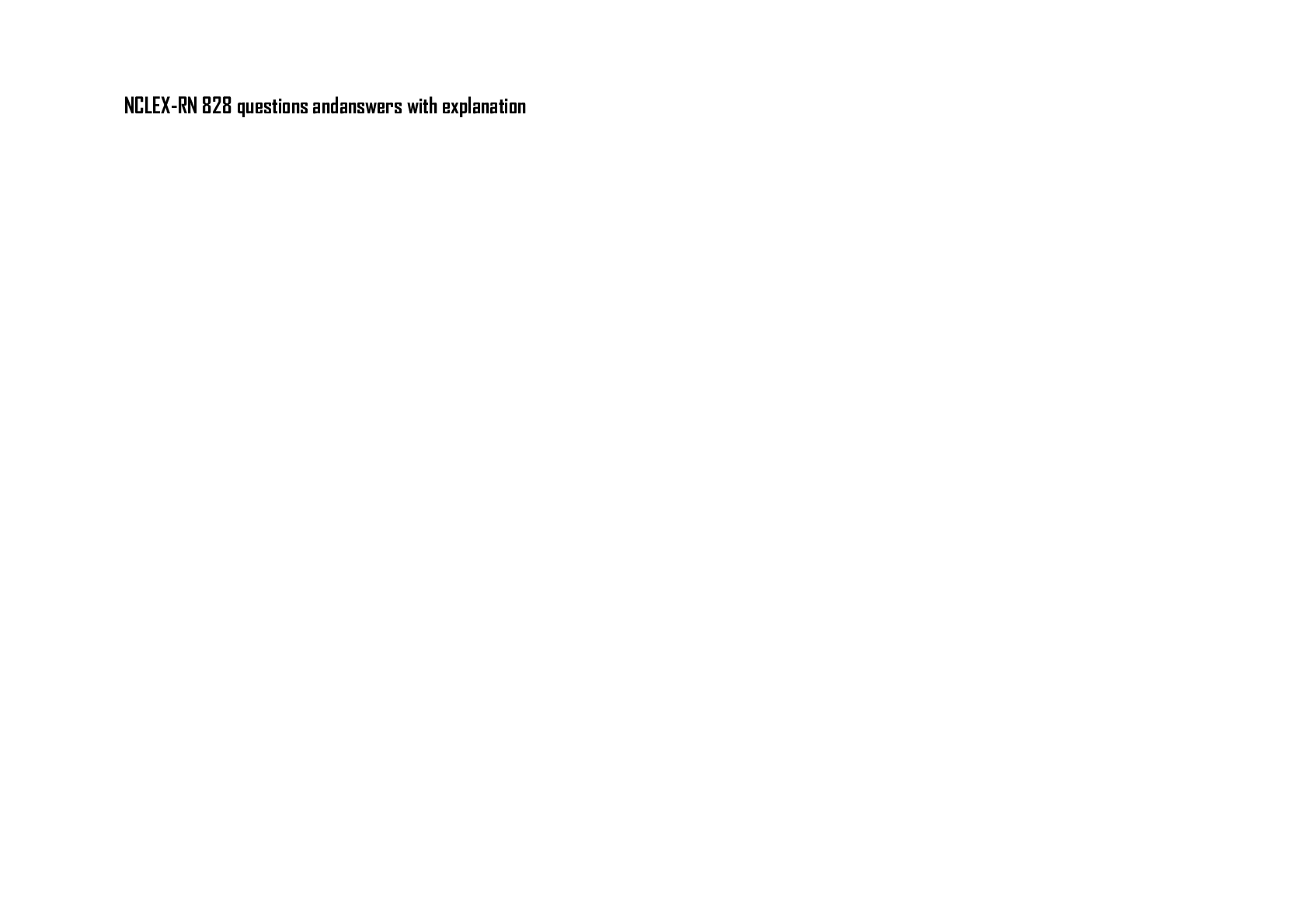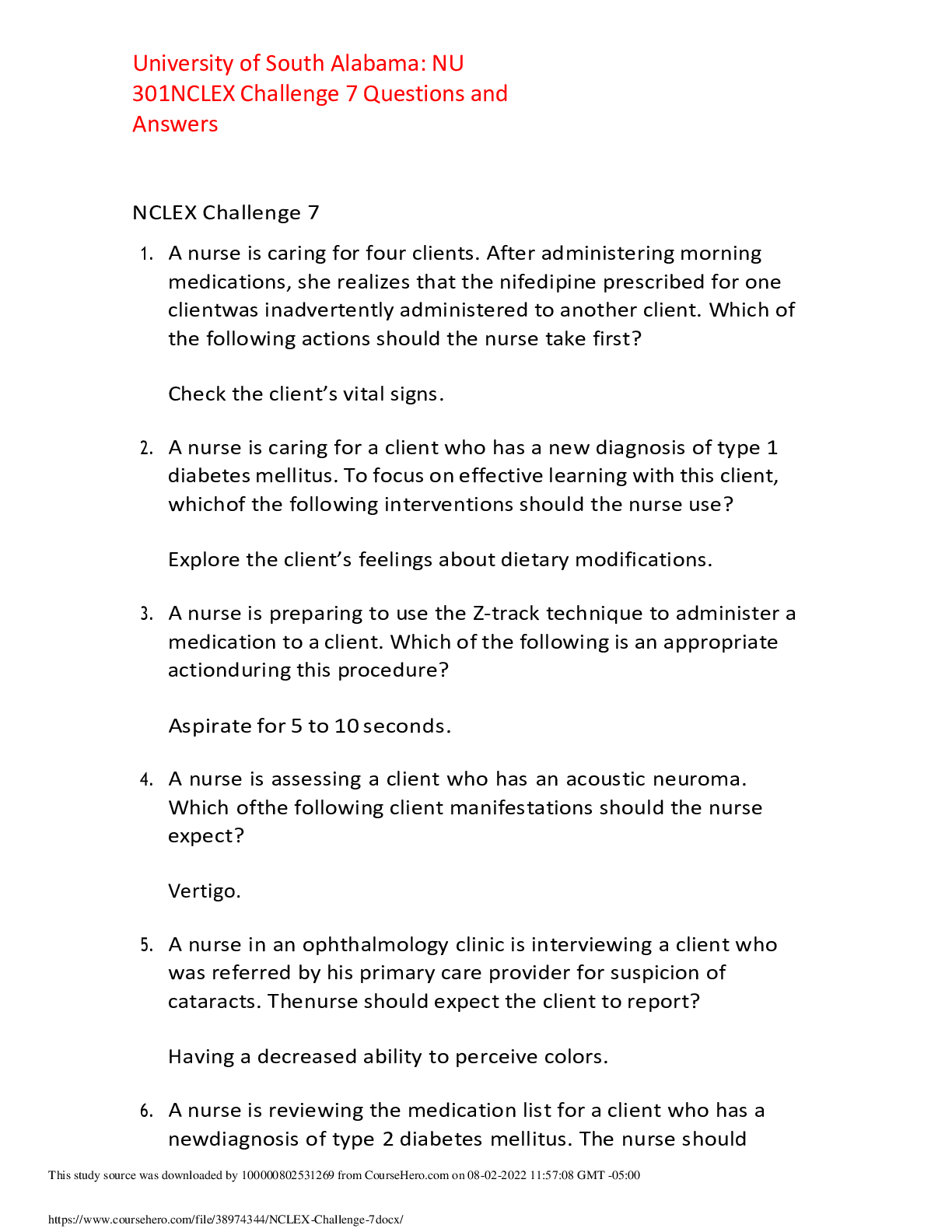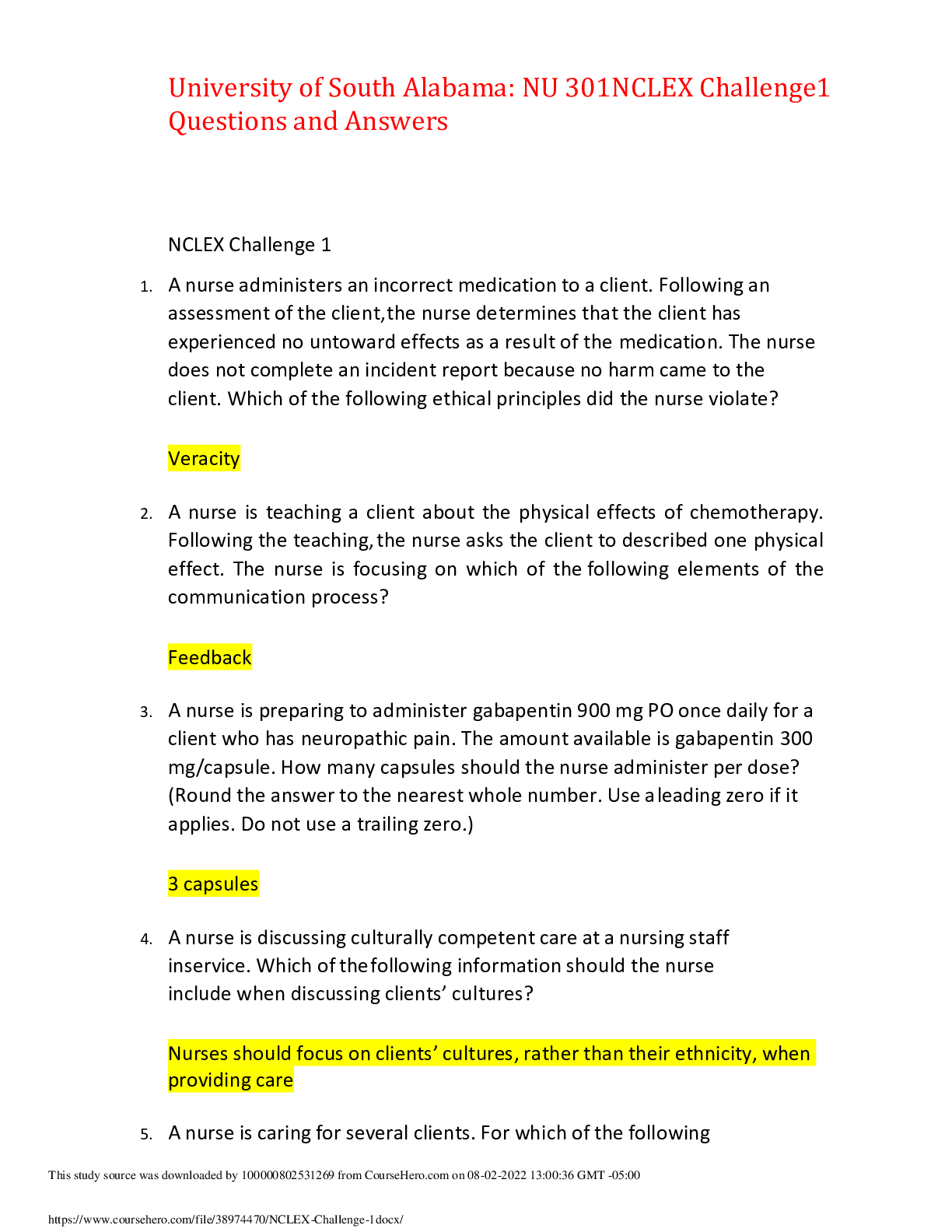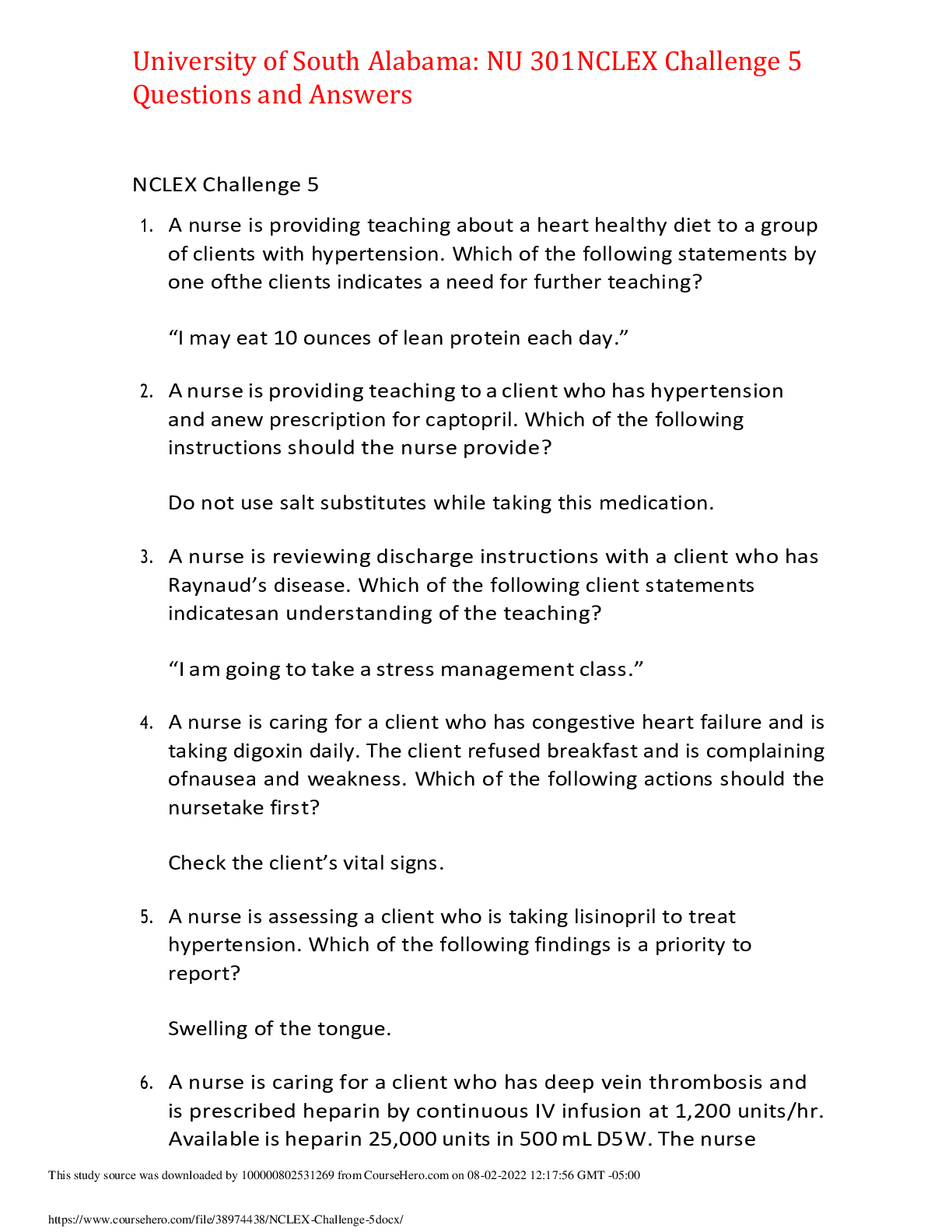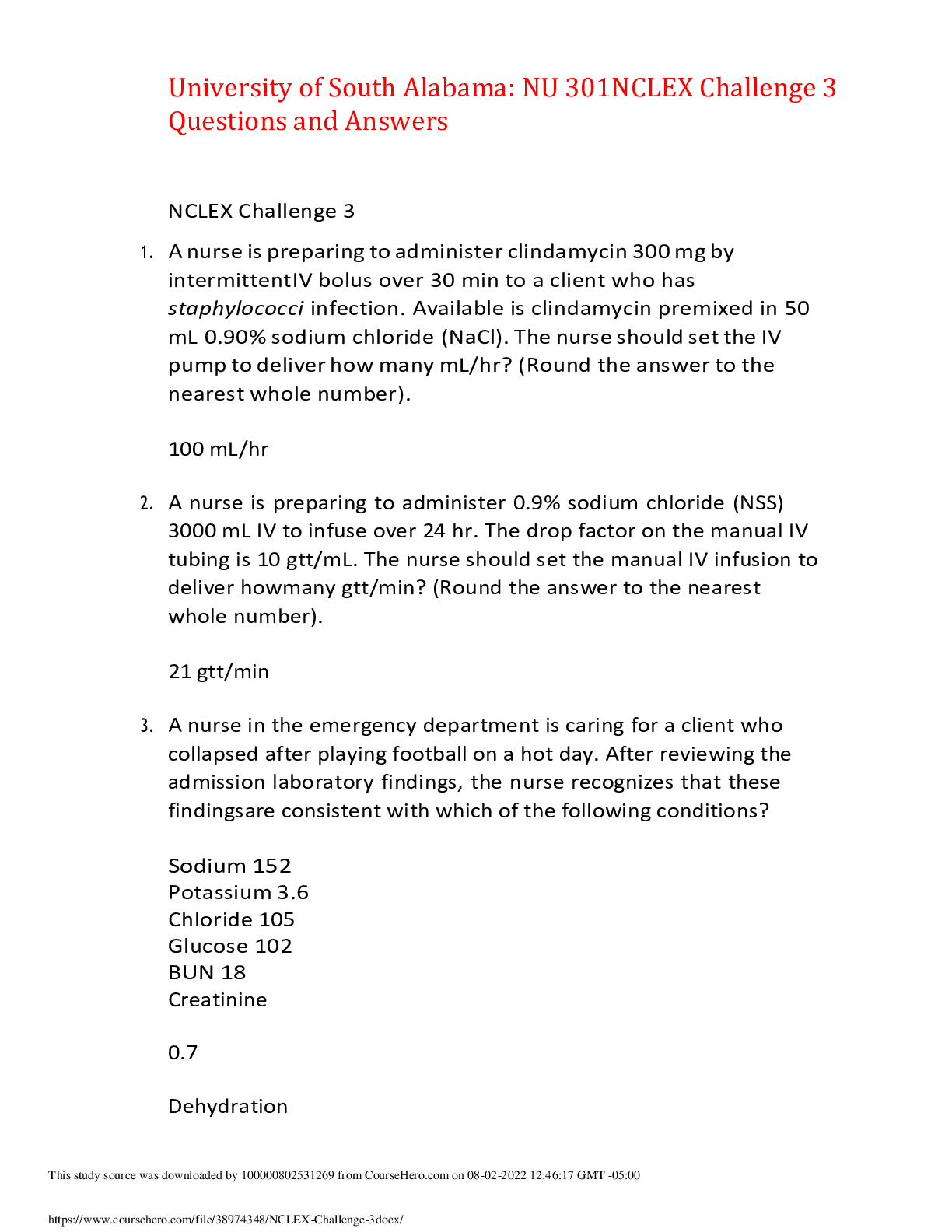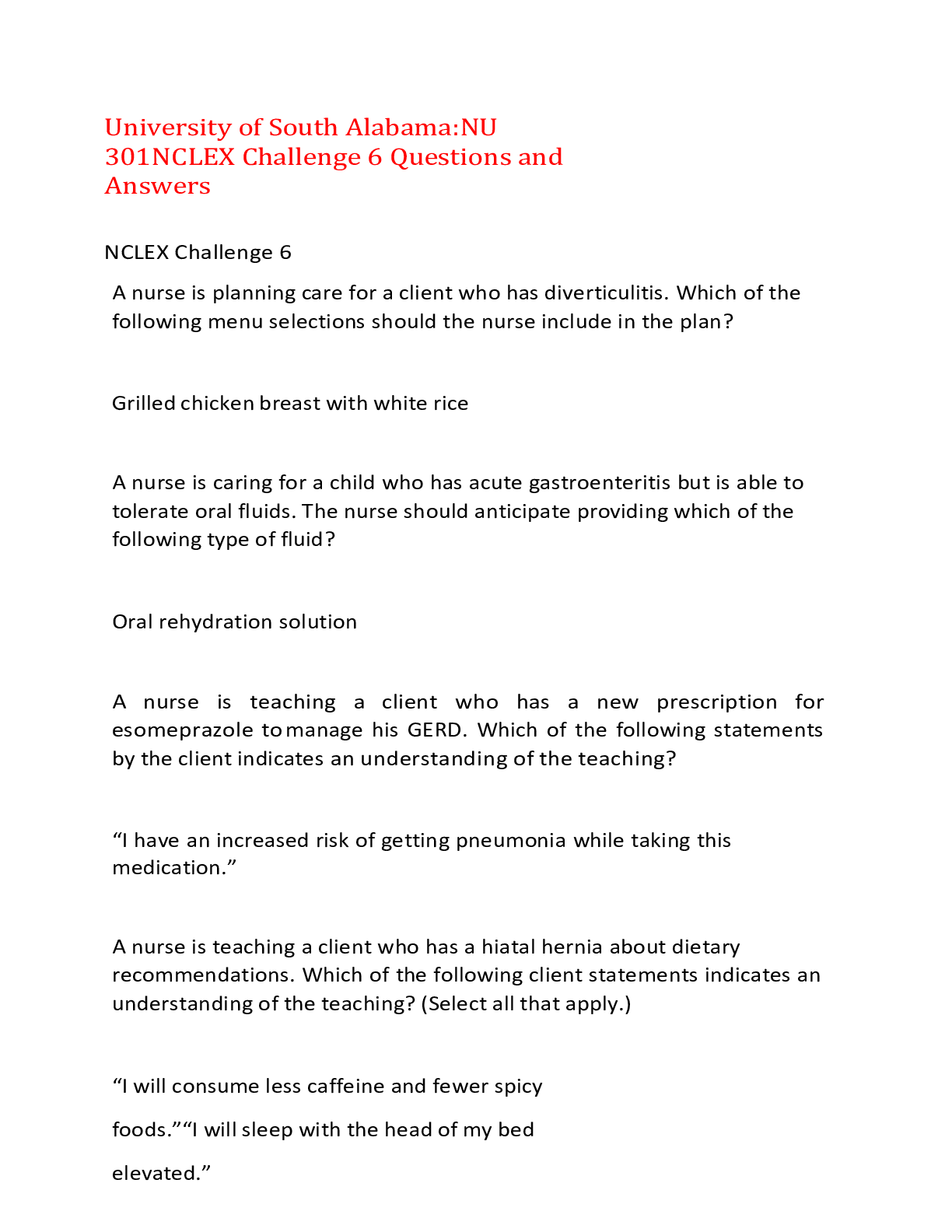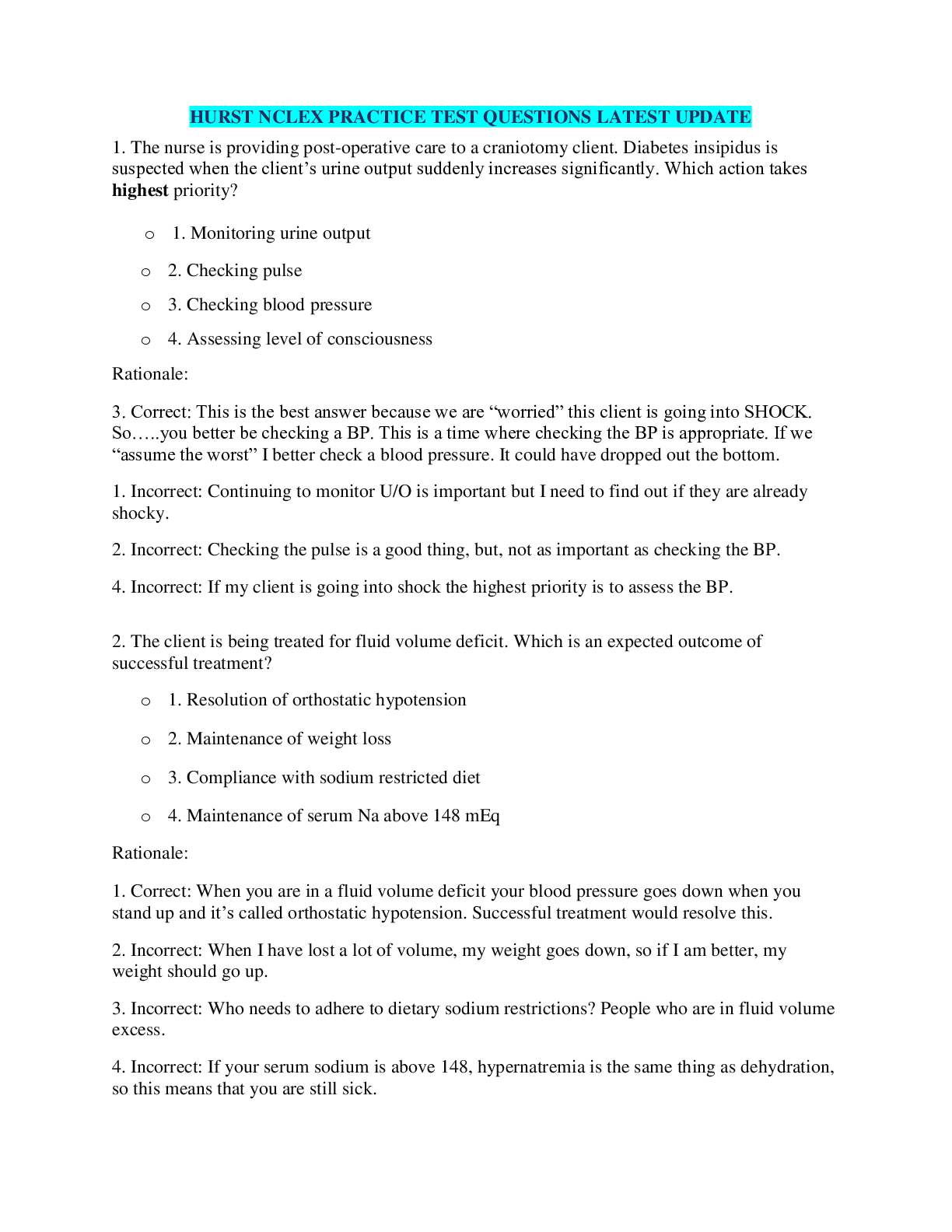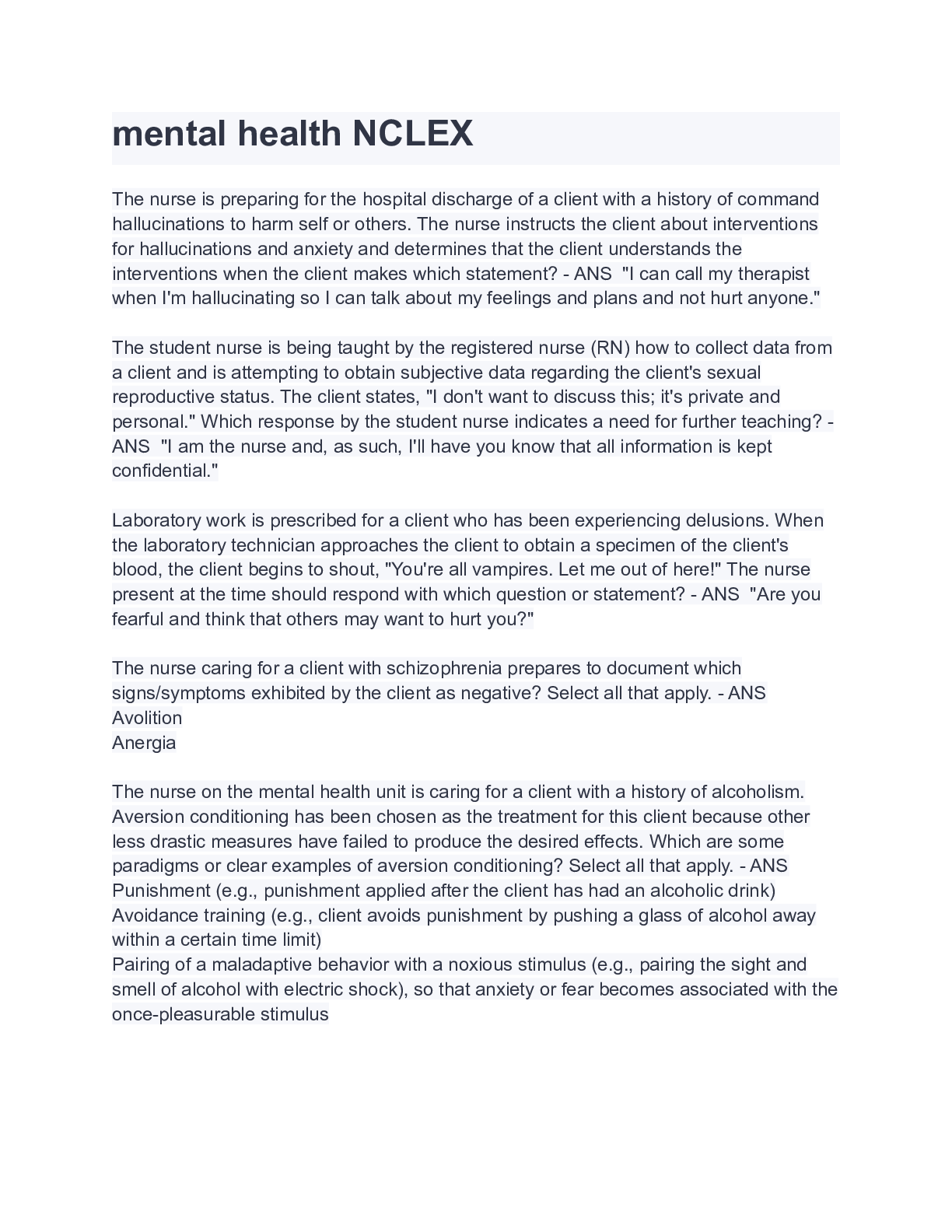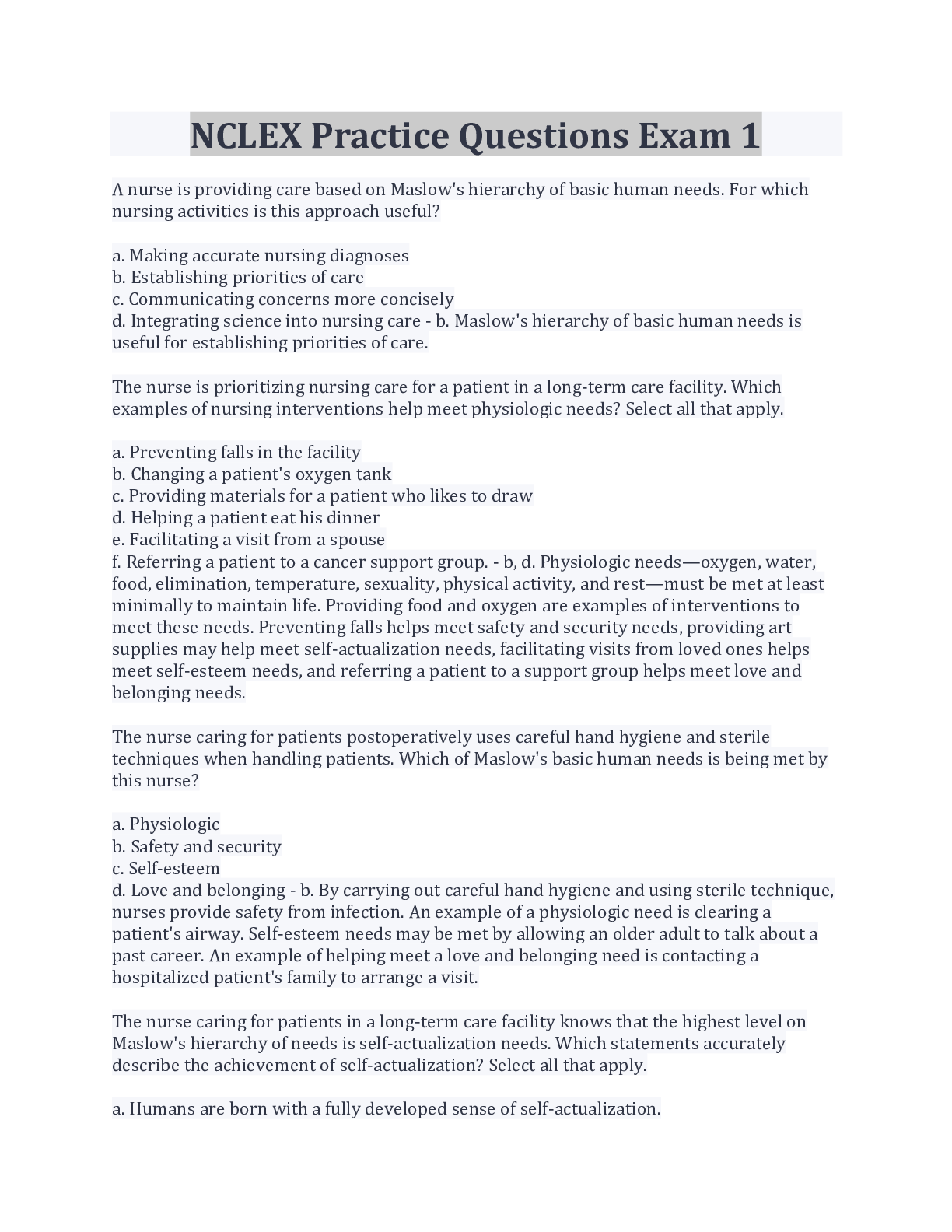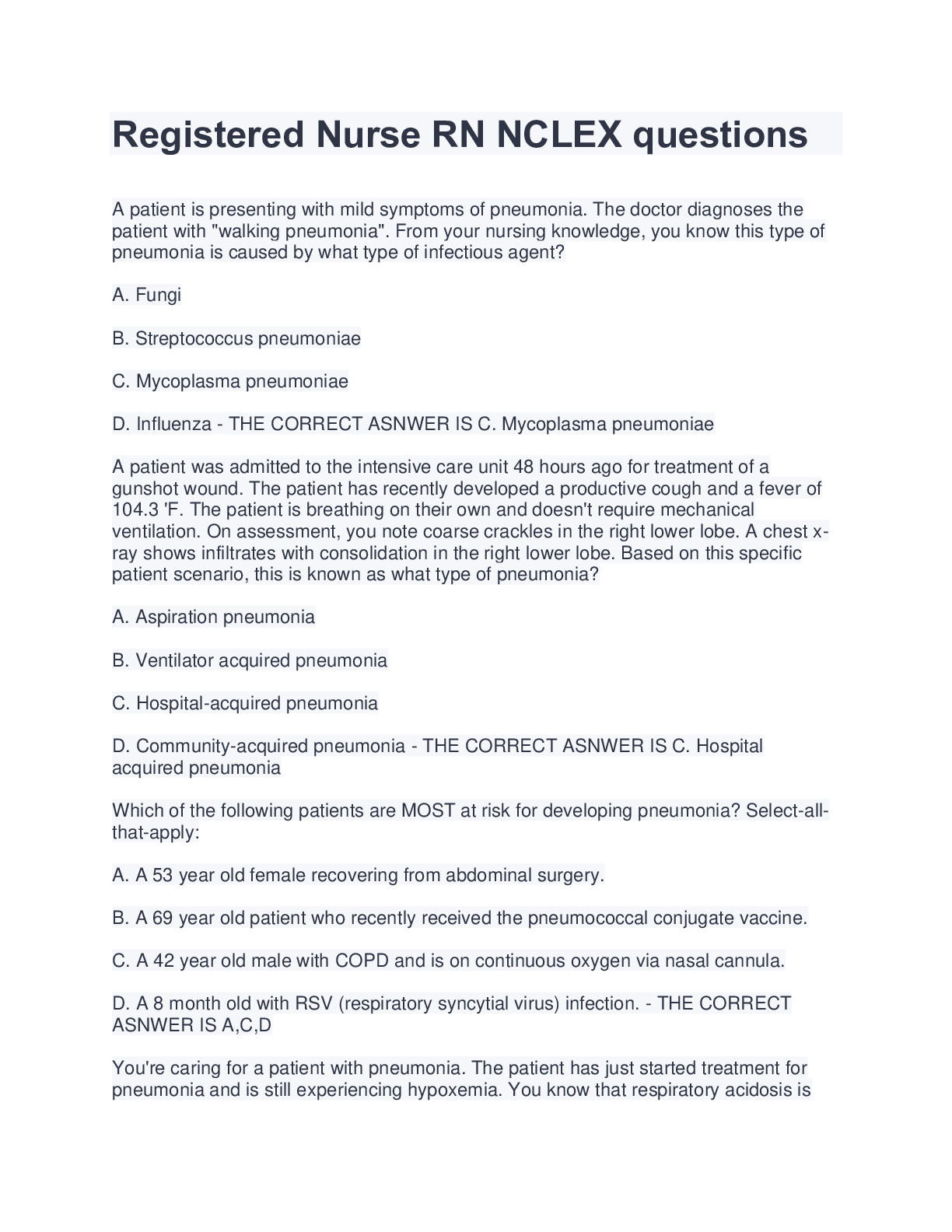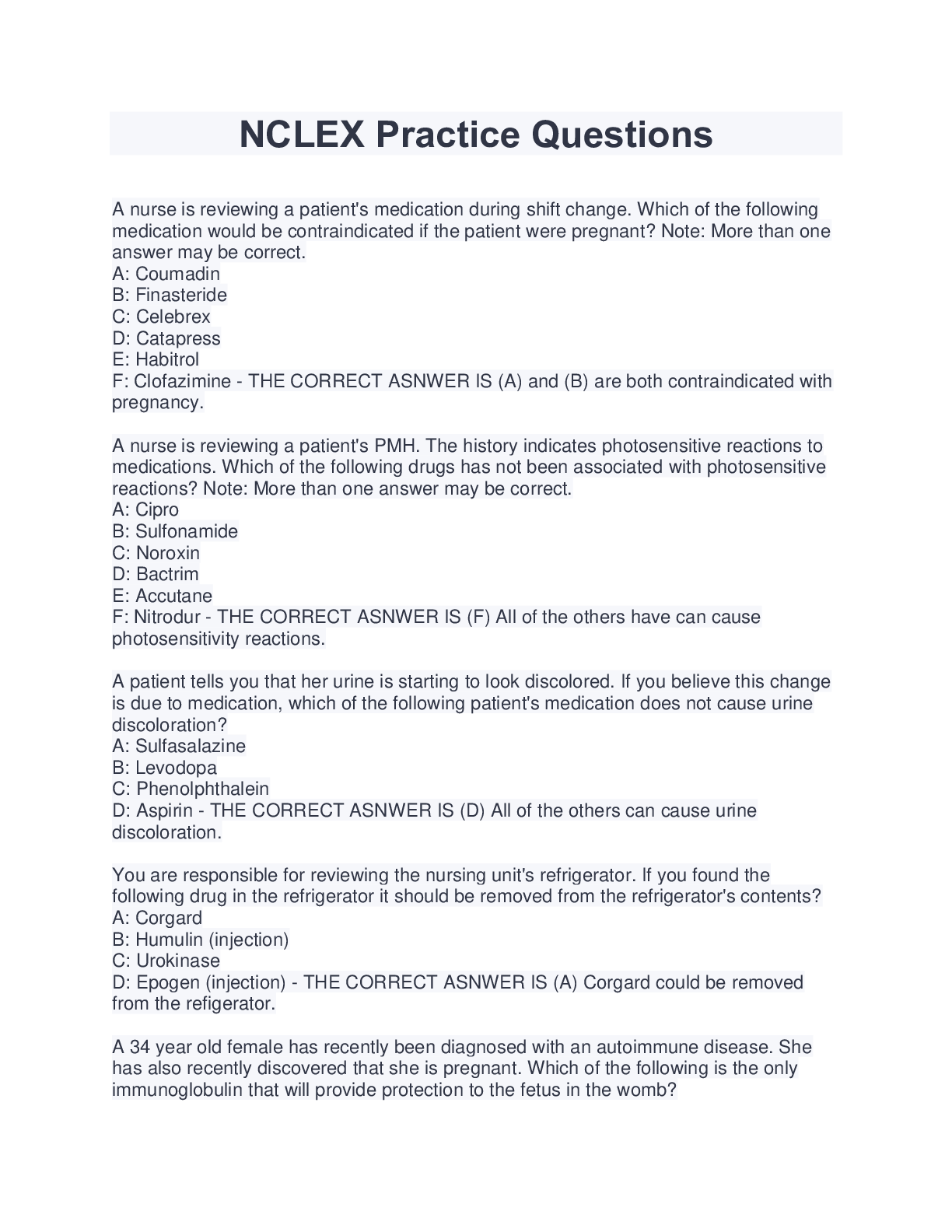*NURSING > NCLEX > NCLEX RN-NURSING Adult Health – Endocrine 170 EXAM QUESTIONS AND ANSWERS (100% CORRECT) (All)
NCLEX RN-NURSING Adult Health – Endocrine 170 EXAM QUESTIONS AND ANSWERS (100% CORRECT)
Document Content and Description Below
1. A client is brought to the emergency department in an unresponsive state, and a diagnosis of hyperglycemic hyperosmolar state (HHS) is made. The nurse would immediately prepare to initiate which... anticipated health care provider's prescription? 1. Endotracheal intubation 2. 100 units of NPH insulin 3. Intravenous infusion of normal saline 4. Intravenous infusion of sodium bicarbonate 3. Intravenous infusion of normal saline 2. An external insulin pump is prescribed for a client with diabetes mellitus and the client asks the nurse about the functioning of the pump. The nurse bases the response on which information about the pump? 1. Is timed to release programmed doses of shortduration or NPH insulin into the bloodstream at specific intervals 2. Continuously infuses small amounts of NPH insulin into the bloodstream while regularly monitoring blood glucose levels 3. Is surgically attached to the pancreas and infuses regular insulin into the pancreas, which in turn releases the insulin into the bloodstream 4. Gives a small continuous dose of short-duration insulin subcutaneously, and the client can selfadminister a bolus with an additional dose from the pump before each meal Card Set Information Author: nursedaisy98 ID: 256678 Filename: Adult Health - Endocrine Updated: 2014-04-20 14:58:06 Tags: NCLEX RN Folders: Adult Health Description: Endocrine Show Answers:4. Gives a small continuous dose of short-duration insulin subcutaneously, and the client can selfadminister a bolus with an additional dose from the pump before each meal 3. A client with a diagnosis of diabetic ketoacidosis (DKA) is being treated in the emergency department. Which findings would the nurse expect to note as confirming this diagnosis? Select all that apply. 1. Increase in pH 2. Comatose state 3. Deep, rapid breathing 4. Decreased urine output 5. Elevated blood glucose level 6. Low plasma bicarbonate level o 3. Deep, rapid breathing o 5. Elevated blood glucose level o 6. Low plasma bicarbonate level 4. The nurse teaches a client with diabetes mellitus about differentiating between hypoglycemia and ketoacidosis. The client demonstrates an understanding of the teaching by stating that a form of glucose should be taken if which symptoms develop? Select all that apply. 1. Polyuria 2. Shakiness 3. Palpitations 4. Blurred vision 5. Lightheadedness 6. Fruity breath odor o 2. Shakiness o 3. Palpitations o 5. Lightheadedness 5. A client with diabetes mellitus demonstrates acute anxiety when first admitted to the hospital for the treatment of hyperglycemia. What is the most appropriate intervention to decrease the client'sanxiety? 1. Administer a sedative. 2. Convey empathy, trust, and respect toward the client. 3. Ignore the signs and symptoms of anxiety so that they will soon disappear. 4. Make sure that the client knows all the correct medical terms to understand what is happening. 2. Convey empathy, trust, and respect toward the client. 6. The nurse provides instructions to a client newly diagnosed with type 1 diabetes mellitus. The nurse recognizes accurate understanding of measures to prevent diabetic ketoacidosis when the client makes which statement? 1. "I will stop taking my insulin if I'm too sick to eat." 2. "I will decrease my insulin dose during times of illness." 3. "I will adjust my insulin dose according to the level of glucose in my urine." 4. "I will notify my health care provider (HCP) if my blood glucose level is higher than 250 mg/dL." 4. "I will notify my health care provider (HCP) if my blood glucose level is higher than 250 mg/dL." 7. A client is admitted to a hospital with a diagnosis of diabetic ketoacidosis (DKA). The initial blood glucose level was 950 mg/dL. A continuous intravenous infusion of short-acting insulin is initiated, along with intravenous rehydration with normal saline. The serum glucose level is now 240 mg/dL. The nurse would next prepare to administer which item? 1. Ampule of 50% dextrose 2. NPH insulin subcutaneously 3. Intravenous fluids containing dextrose 4. Phenytoin (Dilantin) for the prevention of seizures 3. Intravenous fluids containing dextrose 8. The nurse is monitoring a client newly diagnosed with diabetes mellitus for signs of complications. Which sign, if exhibited in the client, would indicate hyperglycemia? 1. Polyuria2. Diaphoresis 3. Hypertension 4. Increased pulse rate 1. Polyuria 9. The nurse is preparing a plan of care for a client with diabetes mellitus who has hyperglycemia. The nurse places highest priority on which client problem? 1. Lack of knowledge 2. Inadequate fluid volume 3. Compromised family coping 4. Inadequate consumption of nutrients 2. Inadequate fluid volume 10. The home health nurse visits a client with a diagnosis of type 1 diabetes mellitus. The client relates a history of vomiting and diarrhea and tells the nurse that no food has been consumed for the last 24 hours. Which additional statement by the client indicates a need for further teaching? 1. "I need to stop my insulin." 2. "I need to increase my fluid intake." 3. "I need to monitor my blood glucose every 3 to 4 hours." 4. "I need to call the health care provider (HCP) because of these symptoms." 1. "I need to stop my insulin." 11. The nurse is caring for a client after hypophysectomy and notes clear nasal drainage from the client's nostril. The nurse should take which initial action? 1. Lower the head of the bed. 2. Test the drainage for glucose. 3. Obtain a culture of the drainage. 4. Continue to observe the drainage. 2. Test the drainage for glucose. 12. After several diagnostic tests, a client is diagnosed with diabetes insipidus. The nurse performs an assessment on the client, knowing that which symptom is most indicative of this disorder?1. Fatigue 2. Diarrhea 3. Polydipsia 4. Weight gain 3. Polydipsia 13. A client is admitted to an emergency department, and a diagnosis of myxedema coma is made. Which action would the nurse prepare to carry out initially? 1. Warm the client. 2. Maintain a patent airway. 3. Administer thyroid hormone. 4. Administer fluid replacement. 2. Maintain a patent airway. 14. The nurse is caring for a client admitted to the emergency department with diabetic ketoacidosis (DKA). In the acute phase, the nurse plans for which priority intervention? 1. Correct the acidosis. 2. Administer 5% dextrose intravenously. 3. Apply a monitor for an electrocardiogram. 4. Administer short-duration insulin intravenously. 4. Administer short-duration insulin intravenously. 15. A client with type 1 diabetes mellitus calls the nurse to report recurrent episodes of hypoglycemia with exercising. Which statement by the client indicates an inadequate understanding of the peak action of NPH insulin and exercise? 1. "The best time for me to exercise is after I eat." 2. "The best time for me to exercise is after breakfast." 3. "The best time for me to exercise is mid- to late afternoon." 4. "The best time for me to exercise is after my morning snack." 3. "The best time for me to exercise is mid- to late afternoon." 16. The nurse is completing an assessment on a client who is being admitted for a diagnostic workup for primaryhyperparathyroidism. Which client complaint would be characteristic of this disorder? 1. Diarrhea 2. Polyuria 3. Polyphagia 4. Weight gain 2. Polyuria 17. The nurse is caring for a postoperative parathyroidectomy client. Which client complaint would indicate that a life-threatening complication may be developing, requiring notification of the health care provider immediately? 1. Laryngeal stridor 2. Abdominal cramps 3. Difficulty in voiding 4. Mild to moderate incisional pain 1. Laryngeal stridor 18. A client is diagnosed with pheochromocytoma. The nurse understands that pheochromocytoma is a condition that has which characteristic? 1. Causes profound hypotension 2. Is manifested by severe hypoglycemia 3. Is not curable and is treated symptomatically 4. Causes the release of excessive amounts of catecholamines 4.Causes the release of excessive amounts of catecholamines 19. The nurse is monitoring a client who was diagnosed with type 1 diabetes mellitus and is being treated with NPH and regular insulin. Which client complaints would alert the nurse to the presence of a possible hypoglycemic reaction? Select all that apply. 1. Tremors 2. Anorexia 3. Irritability 4. Nervousness 5. Hot, dry skin 6. Muscle crampso 1. Tremors o 3. Irritability o 4. Nervousness 20. The nurse is performing an assessment on a client with pheochromocytoma. Which assessment data would indicate a potential complication associated with this disorder? 1. A coagulation time of 5 minutes 2. A urinary output of 50 mL/hour 3. A blood urea nitrogen level of 20 mg/dL 4. A heart rate that is 90 beats/minute and irregular 4. A heart rate that is 90 beats/minute and irregular 21. The nursing instructor asks a student to describe the pathophysiology that occurs in Cushing's disease. Which statement by the student indicates an accurate understanding of this disorder? 1. "Cushing's disease results from an oversecretion of insulin." 2. "Cushing's disease results from an undersecretion of corticotropic hormones." 3. "Cushing's disease results from an undersecretion of mineralocorticoid hormones." 4. "Cushing's disease results from an increased pituitary secretion of adrenocorticotropic hormone." 4. "Cushing's disease results from an increased pituitary secretion of adrenocorticotropic hormone." 22. The nurse performs a physical assessment on a client with type 2 diabetes mellitus. Findings include a fasting blood glucose level of 120 mg/dL, temperature of 101° F, pulse of 88 beats/minute, respirations of 22 breaths/minute, and blood pressure of 100/72 mm Hg. Which assessment would be of most concern to the nurse? 1. Pulse 2. Respiration 3. Temperature 4. Blood pressure3. Temperature 23. The nurse is interviewing a client with type 2 diabetes mellitus. Which statement by the client indicates an understanding of the treatment for this disorder? 1. "I take oral insulin instead of shots." 2. "By taking these medications, I am able to eat more." 3. "When I become ill, I need to increase the number of pills I take." 4. "The medications I'm taking help release the insulin I already make." 4. "The medications I'm taking help release the insulin I already make." 24. The nurse is providing discharge instructions to a client who has Cushing's syndrome. Which client statement indicates that instructions related to dietary management are understood? 1. "I will need to limit the amount of protein in my diet." 2. "I should eat foods that have a lot of potassium in them." 3. "I am fortunate that I can eat all the salty foods I enjoy." 4. "I am fortunate that I do not need to follow any special diet." 2. "I should eat foods that have a lot of potassium in them." 25. The nurse is caring for a client who is 2 days postoperative following an abdominal hysterectomy. The client has a history of diabetes mellitus and has been receiving regular insulin according to capillary blood glucose testing four times a day. A carbohydratecontrolled diet has been prescribed but the client has been complaining of nausea and is not eating. On entering the client's room, the nurse finds the client to be confused and diaphoretic. Which action is most appropriate at this time? 1. Call a code to obtain needed assistance immediately. 2. Obtain a capillary blood glucose level and perform a focused assessment. 3. Ask the unlicensed assistive personnel (UAP) to staywith the client while obtaining 15 to 30 g of a carbohydrate snack for the client to eat. 4. Stay with the client and ask the UAP to call the health care provider (HCP) for a prescription for intravenous 50% dextrose. 2. Obtain a capillary blood glucose level and perform a focused assessment. 26. The nurse is caring for a client with pheochromocytoma who is scheduled for adrenalectomy. In the preoperative period, what should the nurse monitor as the priority? 1. Vital signs 2. Intake and output 3. Blood urea nitrogen results 4. Urine for glucose and ketones 1. Vital signs 27. The nurse is preparing a client with a new diagnosis of hypothyroidism for discharge. The nurse determines that the client understands discharge instructions if the client states that which symptoms are associated with this diagnosis? Select all that apply. 1. Tremors 2. Weight loss 3. Feeling cold 4. Loss of body hair 5. Persistent lethargy 6. Puffiness of the face o 3. Feeling cold o 4. Loss of body hair o 5. Persistent lethargy o 6. Puffiness of the face 28. A client has just been admitted to the nursing unit following thyroidectomy. Which assessment is the priority for this client? 1. Hypoglycemia 2. Level of hoarseness 3. Respiratory distress4. Edema at the surgical site 3. Respiratory distress 29. A client has been diagnosed with hyperthyroidism. Which signs and symptoms may indicate thyroid storm, a complication of this disorder? Select all that apply. 1. Fever 2. Nausea 3. Lethargy 4. Tremors 5. Confusion 6. Bradycardia o 1. Fever o 2. Nausea o 4. Tremors o 5. Confusion 30. The nurse is caring for a client scheduled for a transsphenoidal hypophysectomy. The preoperative teaching instructions should include which most important statement? 1. "Your hair will need to be shaved." 2. "You will receive spinal anesthesia." 3. "You will need to ambulate after surgery." 4. "Brushing your teeth will not be permitted for at least 2 weeks after surgery." 4. "Brushing your teeth will not be permitted for at least 2 weeks after surge [Show More]
Last updated: 1 year ago
Preview 1 out of 101 pages

Reviews( 0 )
Document information
Connected school, study & course
About the document
Uploaded On
Aug 08, 2021
Number of pages
101
Written in
Additional information
This document has been written for:
Uploaded
Aug 08, 2021
Downloads
0
Views
40




